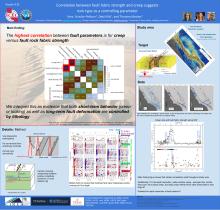Correlation between fault fabric strength and creep suggests rock type as a controlling parameter
Vera Schulte-Pelkum, Debi Kilb, & Thorsten W. BeckerPublished September 7, 2025, SCEC Contribution #14706, 2025 SCEC Annual Meeting Poster #031 (PDF)
Faults can exhibit creep at the surface and/or at depth along some fault sections and be locked in adjacent sections. While rock type is thought to be a parameter that controls this type of behavior, other parameters, such as fault geometry, have been suggested as alternative explanations. Long-term deformation at and around faults leads to the development of fault-related rock fabric. We measure the latter in situ across California by analyzing receiver function arrivals from contrasts in anisotropy. Our method maps the strike, depth, and strength of rock fabric in a narrow footprint below each seismic station. We find that in the vicinity of faults, the strike of the imaged fabric is parallel to the fault strike in most cases. However, we also find large variations in the strength of the fault-related fabric among different faults as well as along the same fault. Along the San Andreas fault (SAF) system, weak fabric dominates on the locked Cholame, Carrizo Plain, Big Bend, and Mojave segments, while strong fabric is seen in the creeping sections from Parkfield to the Calaveras junction and on the southernmost SAF. We correlate fault fabric strength with surface creep and find that the match between the two is comparable to or better than a previously proposed correlation between creep and fault geometry. A significant exception is a mismatch along the San Jacinto fault zone, which shows no surface creep but has strong fabric contrasts extending into the middle crust past seismogenic depths. However, deep creep has been observed for this fault zone in other studies, consistent with our results. We conclude that 1) rock type likely controls creep behavior as well as long-term fault fabric development, and 2) our method, which can quantitatively measure orientation, strength, and depth of rock fabric, may contribute to a better understanding of creep-related fault behavior in situ at depth.
Key Words
fault fabric, receiver functions, creep
Citation
Schulte-Pelkum, V., Kilb, D., & Becker, T. W. (2025, 09). Correlation between fault fabric strength and creep suggests rock type as a controlling parameter. Poster Presentation at 2025 SCEC Annual Meeting.
Related Projects & Working Groups
Seismology




